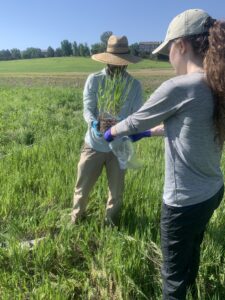Welcome to week two! I began this week by meeting another undergraduate student that we would be working with named Emily. After she got the tour of the lab and met everyone else, Adam began to walk us through important sterile techniques. Sterile techniques are important for keeping a sample pure and preventing the microbes living in the air and on surfaces from contaminating the sample. These techniques involve using ethanol and quatricide to disinfect surfaces and tools. We also use flame from a Bunsen burner to further clean the tools and the air around the sample. After going through these techniques we moved on to mixing the ethanol needed for future lab work. This involved calculating the ratio of water to ethanol and precisely measuring each amount so we had a 70% ethanol mixture. After completing this process with several bottles of ethanol we finished for the day and I biked home.
Tuesday we began preparing the lab for our experiment which would begin on Friday. We organized the desks and cleared previous experimental materials. Adam also showed us the autoclave which is used to completely sterilize used equipment. I ended the day by presenting some of the information I learned through my research last week.
Wednesday I completed an online course for lab safety through the university website. Afterwards we continued preparing the lab for Friday.
On Thursday we prepared the FAA which would be used to store the roots after we collected them from the samples collected on Friday. FAA consists of a mixture of formaldehyde, acetic acid, and ethanol. After preparing that we made sure we had all of our materials ready for the dyeing process on Monday.
We started Friday with an early morning and headed to ChatField Farms at 7. We headed out to the plot we would be sampling from and set up our materials. The plot involved several rows with different treatments of RoundUp. For each plot we took two samples of smooth brome grass and its roots. It took around 2 hours to go through each row and collect all of the samples. Once we finished we took them back to the lab and began the process of collecting our root samples. For each sample of grass from the farm we took around 20 to 30 of the smallest roots from the plant and placed them in a test tube. We then filled the test tubes with FAA and placed them in the fridge. These test tubes will later be dyed and observed through a microscope. We also took one of these small roots and stored it in ethanol so it could be sequenced for DNA. We did this for every single sample and left them in the fridge over the weekend.
On Saturday I took an Uber to go get my second dose of the Pfizer vaccine and then headed to a coffee shop for some lunch. Sunday morning I was feeling the effects of the vaccine so I stayed in bed and read my book. Around 12 I started to feel better so I went for a bike ride and worked on my blog!


Lab work at its finest and inconvenient tome for a vaccination but when is it convenient?